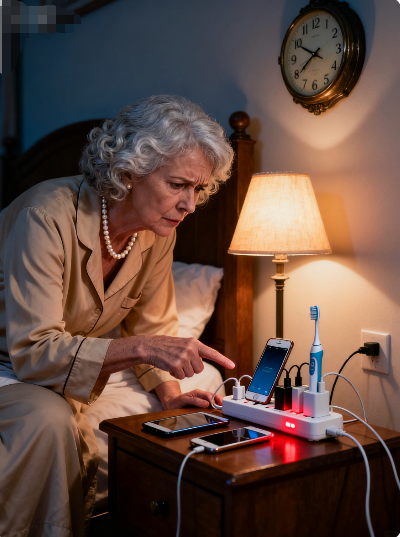
Leaving This Device Plugged in Overnight Might Waste Electricity and Damage…
You finish your evening routine, turn off the lamp, and settle into bed. Around you, the house is quiet, but it’s not entirely asleep. A constellation of tiny, colored lights glows in the darkness—the red standby light on the television, the green power adapter for your laptop, the blue clock on the microwave. It’s a familiar, modern comfort. But what if this habit of leaving devices plugged in is quietly costing you money and, more importantly, posing a hidden risk to your home and health?
For many of us in our 50s, 60s, and beyond, who remember a time before a device for everything, it’s easy to overlook the small electronics we use every day. We plug them in and forget about them. However, one common device, in particular, is a prime culprit for energy waste and a potential fire hazard when left plugged in unattended for hours: your smartphone or tablet charger.
That simple block that you plug into the wall to charge your phone might seem harmless, but leaving it plugged in overnight, especially after your device is fully charged, is a practice worth reconsidering.
The Silent Energy Drain: “Vampire Power”
Even when your phone isn’t connected, a charger left plugged into the wall continues to draw a small amount of electricity. This phenomenon is known as “vampire power,” “phantom load,” or “standby power.” It’s the energy consumed by electronics when they are turned off but still plugged in.
While the cost for a single charger might seem negligible—perhaps a few dollars a year—the cumulative effect of all the chargers, laptops, gaming consoles, and other electronics in your home can add up. According to the U.S. Department of Energy, phantom load can account for 5-10% of your annual electricity bill. In an era of rising energy costs, that’s real money trickling away, night after night, for absolutely no benefit.
The Greater Concern: Wear, Tear, and Potential Hazards
The financial waste is one thing, but the potential safety risk is more significant. While modern chargers are built with safety features, they are not infallible, especially as they age.
- Heat Buildup: A charging block converts the high-voltage AC (alternating current) from your wall outlet into the low-voltage DC (direct current) your phone needs. This process generates heat. When a charger is left plugged in for extended periods, it continually generates this low-level heat, which can degrade its internal components over time. This constant thermal stress can make the charger less efficient and more prone to failure.
- The Risk of Overheating: If a charger is faulty, damaged, or of poor quality, the risk increases. A damaged cord or a cheap, off-brand charger can overheat, potentially leading to a fire. This risk is heightened when the charger is placed on a flammable surface like a bed, under a pillow, or buried in a rug, or when it’s plugged into an overloaded power strip.
- Battery Degradation: For the device itself, leaving it plugged in after it reaches 100% charge can, over time, contribute to long-term battery degradation. Modern devices are smart enough to stop charging when full, but consistently keeping a battery at 100% charge can still create subtle stress that reduces its overall lifespan, meaning you’ll find your phone’s battery doesn’t hold a charge as well as it used to.
A Simple, Safer Routine
Breaking this habit is a simple way to save money and add a layer of safety to your home. Here’s an easy plan:
- Charge During the Day: Make a habit of charging your phone or tablet while you’re awake and nearby. For instance, plug it in while you’re reading, watching television, or working at your desk. This allows you to monitor it and unplug it once it’s charged.
- Use a Power Strip with a Switch: Plug your chargers and other electronics into a power strip. Before you go to bed, simply flip the switch on the power strip to cut off all power to the devices. This is an easy way to eliminate vampire power for multiple devices at once.
- Unplug After Use: Get into the routine of unplugging the charger from the wall outlet once you’ve disconnected your device. This is the most effective way to ensure it’s not drawing any power or generating any heat.
- Inspect Your Chargers: Regularly check your charging cables and blocks for any signs of damage, such as fraying wires, cracks, or discoloration. If you see any damage, replace the charger immediately. Don’t use off-brand, uncertified chargers.
This small change is not about living in fear; it’s about practicing mindful energy use and proactive safety. It’s a modern version of the old adage, “better safe than sorry.” By taking this simple step, you’re not just saving a little on your utility bill; you’re contributing to a safer home environment. So tonight, after you unplug your phone, take a second to unplug the charger, too. It’s a small action that brings big peace of mind.